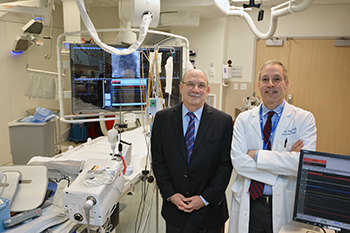
Michael Cleman, MD, (left), and Henry Cabin, MD, launched Yale New Haven Hospital's Interventional Cardiology program 30 years ago when they started a fellowship to train young cardiologists to perform angioplasty.
In 1985, cardiologists Henry Cabin, MD, and Michael W. Cleman, MD, were performing a relatively new procedure called angioplasty – the only way at the time to open blocked blood vessels without open-heart surgery.
During angioplasty, the physician makes a small incision, usually in a patient's groin, and threads a catheter through the arteries to the heart to clear blockages. Drs. Cabin and Cleman started a fellowship program to teach young cardiologists the procedure, and Yale New Haven Hospital's Interventional Cardiology program was born.
"We saw the importance of providing non-surgical options to treat coronary artery diseases," said Dr. Cleman, director of the YNHH Cardiac Catheterization Laboratory. "As equipment and techniques improved, we were able to treat more patients and build the program over time."
YNHH interventional cardiologists have been involved in many advancements in the past three decades, including developing and placing the first intracoronary stent in New England. The stent keeps arteries open after angioplasty to help prevent future blockages. Yale New Haven interventional cardiologists have also been involved in early development and use of atherectomy devices, which remove plaque from arteries; novel gene and cell-based therapies to "grow" new heart tissue and blood vessels; and techniques and technology to treat chronically blocked arteries.
Today, interventional cardiologists perform more than 10,000 procedures a year at YNHH – including different types of angioplasties and other treatments for coronary artery conditions and peripheral vascular diseases, which affect the arms, legs and other areas of the body. They are also involved in 90 clinical trials to test new treatments.
One of the newer treatments is transcatheter aortic valve replacement (TAVR), in which a catheter is used to deliver a new aortic valve to replace the diseased one. YNHH was the first Connecticut hospital to offer TAVR for patients with severe aortic stenosis (narrowing of the heart's aortic valve) and now performs about 200 TAVRs annually.
"TAVR and other advancements are excellent examples of how interventional cardiology can minimize the need for open-heart surgery, particularly in cases where surgery is risky," said Dr. Cabin, acting chief, Cardiovascular Medicine, and medical director, Heart and Vascular Center. "It's been rewarding to be involved with a program that has yielded innovations that have improved outcomes for so many people."
